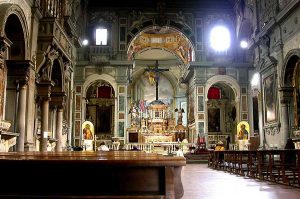Tours to Fund an Ognissanti Restoration
 The professional tour guides of the Mercurio Association will offer their services to accompany visitors around Florence’s Ognissanti Church on January 4, 7 and 14, 2017 every half hour between 4 and 5:30 pm to raise funds to restore one of its works. A tour in English is scheduled on January 7 at 4:15 pm. A minimum €5 donation is required, which will be given to help fund a restoration.
The professional tour guides of the Mercurio Association will offer their services to accompany visitors around Florence’s Ognissanti Church on January 4, 7 and 14, 2017 every half hour between 4 and 5:30 pm to raise funds to restore one of its works. A tour in English is scheduled on January 7 at 4:15 pm. A minimum €5 donation is required, which will be given to help fund a restoration.
The tours for the “Treat Yourself To a Restoration” initiative at Ognissanti provide an opportunity to see discover some of the secrets behind this church founded in the 13th century as well as to contribute to preserving Florence’s cultural patrimony. The church contains a wooden crucifix by Giotto, and the tomb of Botticelli, the artist of Primavera (Spring) and the Birth of Venus in the Uffizi.
Impressions of Ognissanti neighborhood today: two big hotels in the square supplying the well-heeled tourists sought after by expensive shops and restaurants; old buildings occupied on the ground floor by a predominance of art galleries, interior designers and antique dealers; and the ghostly-white, unattractive Baroque-style facade of the Church of Ognissanti (All Saints). The real identity of the Ognissanti neighborhood, historic and present, requires some searching.
At Borgognissanti #42 a door separate from the church leads to a refectory frescoed by Domenico Ghirlandaio with a Last Supper (1480).
Yesterday, as today, the Ognissanti neighborhood has its roots in commerce. Around 1230 the area attracted a Lombard order of lay brothers, the Umiliati, who apart from building the church, controlled much of Florence’s vital wool industry. Fleece was purchased from all over Europe from monasteries with flocks of sheep, and delivered to the Umiliati who had a cheap supply of labor in the local Florentines. The workers, who had access to the water of the Arno river and nearby canals necessary for production of wool cloth, lived on the street in homes rented by the brothers or directly across the Carraia bridge in San Frediano.
As the brothers became wealthy, they hired leading artists of the day. Following the Florentine custom that the monastery dining room be frescoed with a Last Supper, they awarded the commission to Domenico Ghirlandaio (1449-94), who had just completed the Santa Fina mural cycle in San Gimignano.
Ghirlandaio turned the existing architecture to good use–the vaulted ceiling of the refectory also became the ceiling of the painted scene. The composition is set up according to the canons of perspective of the day, with a sense of depth provided by the receding floor tiles and another curving section of the vault, distinguished from the real one by its crimson hue and gold, filigree-like border. Two painted windows on either side add a further touch of naturalism.
Below, it is the moment when Jesus announces that someone at the table will betray Him
The figures are arranged in a geometric composition around an unusual horseshoe-shaped table, evidencing Ghirlandaio’s strengths as an artist, his portrayal of faces and visual expression as well as his use of color. Apart from Christ, whose head was repainted by Carlo Maratta during the 17th century, the individualism of each Apostle is clear, in addition to psychological introspection.
The colors are understated yet marvelous, with tunics and drapery in tones of plum, rose, saffron, sage green, raspberry, grays and whites. The tablecloth is a linen one of the period, with blue-stenciled griffins. To the extreme right and left, respectively, are a brass vase and brass plate, right over where the brothers actually would wash their hands before sitting down to eat.
In contrast to the apparent calmness of the scene below, the lunettes are alive with flora and fauna. Cypress, pomegranate and lemon trees in addition to a rather incongruous palm, are silhouetted against a muted sky. Above the treetops a wild frenzy of birds–falcons and quails–are flying as in apprehension of an approaching storm.
Ghirlandaio’s Last Supper was detached for restoration 13 days before the November ‘66 flood, and the mural can be compared on the way out with its underdrawing (sinopia) placed on the side wall.
Ognissanti’s prosperity during medieval period also acted as a magnet for a leading Florentine family, the Vespucci. Bankers and merchants primarily in silk but also in wool originally from near Greve in Chianti, they built their city residences around the monastery and church.
It is not known whether Amerigo Vespucci was born here or in another Vespucci home in the outlying Peretola neighborhood–which is one reason why the local airport in that district is named after the great explorer. It is certain, however, that Amerigo lived on Borgognissanti and that Ghirlandaio portrayed his grandfather, father and older brother Bernardo as patrons in the Church of Ognissanti fresco The Madonna of Mercy (1473). (rosanna cirigliano)
